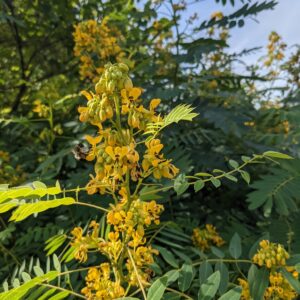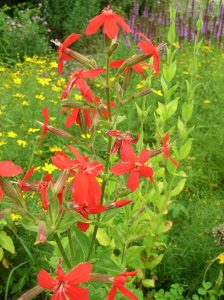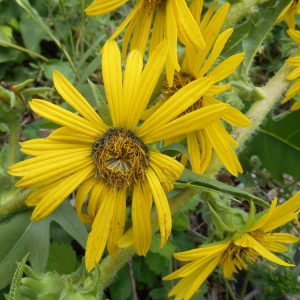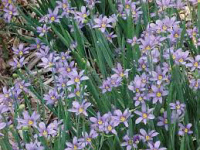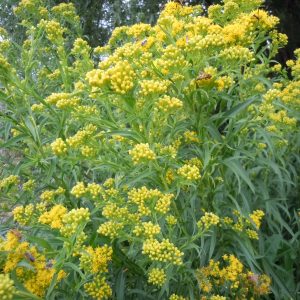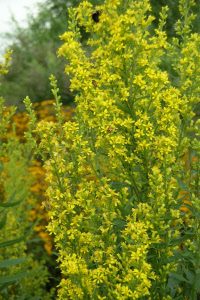Wisconsin Native
Showing 89–96 of 108 results
-
Senna hebecarpa syn. Cassia hebecarpa Wild senna Z 4-8
6” long taxicab yellow racemes in July – August
6 inch long taxicab yellow racemes in July – August
Size: 4’ x 2-6’
Care: full sun in moist well-drained soil
Native: all North America east of Mississippi River from Hudson Bay south to Georgia and Tennessee, Wisconsin native
Wildlife Value: attracts bees, butterflies, birds & hummingbirdsCollected by 1753. Very similar to Senna marilandica except a bit taller, flowers prettier and a slightly bulbous gland as the base of the petiole.
-
Silene regia Royal catchfly Z 5-8
True crimson stars, brighter than a stop light
OUT OF STOCK
True crimson stars, brighter than a stop light, in July – September, from the prairies.
Size: 2-3’ x 1-2’
Care: sun to part shade in moist well-drained soil
Native: from Ohio to Alabama W. to Nebraska, WI native
Wildlife Value: hummingbird favorite.In Greek mythology Silene was a companion of Bacchus who was covered with foam. French plant hunter Andre Michaux may have been the 1st to collect this c. 1800. Grown from seed collected by English planthunter Thomas Nuttall (1786-1859) near St. Louis on the Mississippi River c. 1812.
-
Silphium laciniatum Compass plant Z 4-9
Tall, sunflower-like plant with big, deeply lobed, hairy leaves, that move north and south to follow mid-day sun. Two to five inch wide, sunny-yellow daisies grow at intervals along the top half of the stiff, square, sticky stem from mid-summer into fall.
OUT OF STOCK
Tall, sunflower-like plant with big, deeply lobed, hairy leaves, that move north and south to follow mid-day sun. Two to five inch wide, sunny-yellow daisies grow at intervals along the top half of the stiff, square, sticky stem from mid-summer into fall.
Size: sun to part shade in moist to well-drained soil with its deep taproot
Care: 6- 12’ x 24”
Native: East and central U.S. as far west as the Great Plains, Wisconsin native
Wildlife Value: pollinated by bumblebees, Miner bees, large leaf Cutting and solitary bees, Goldfinches feast on the seeds in fall.
Awards: Missouri Botanic Garden Plant of MeritNatives chewed the plant’s sap like chewing gum. Lakota Sioux made an infusion of the plant is used to deworm horses and humans of and to break up congestion in the lungs. Grew in Bartram’s colonial nursery by 1770’s. Grown at America’s 1st botanic garden, Elgin Botanic Garden 1811.
Named “Compass plant” for its leaves move, facing north and south.
-
Silphium perfoliatum Cup plant Z 3-9
Golden daisies waive at the sun from July to September, its cup shaped leaves hold water where butterflies drink & bathe
Golden daisies waive at the sun from July to September, its cup shaped leaves hold water where butterflies drink & bathe
Can not ship to: Connecticut and New York
Size: 7’ x 3’
Care: full sun to part shade in moist soil
Native: Central North America, native to Wisconsin.
Awards: England’s Royal Horticultural Society Award of MeritSap used by Native Americans to chew and freshen breath. Also used to cure colds, neuralgia, fever, and liver disorders. The Chippewa used to stop lung hemorrhaging, menstrual bleeding and cure chest pain. The Winnebago drank a potion from the plant to purify themselves before a buffalo hunt. For the Iroquois it cured paralysis, prevented children from seeing ghosts and illness caused by the dead. Lakota Sioux: “Children sometimes use the resin as chewing gum. An infusion of the whole plant is used to rid horses and humans of intestinal worms. An infusion of the leaves is used to loosen phlegm in the lungs. Described and classified in 1753.
-
Sisyrinchium angustifolium Blue eyed grass Z 3-9
Cutest petite iris-like foliage sporting blue saucer-shaped flowers with bright yellow stamens in summer.
Cutest petite iris-like foliage sporting blue saucer-shaped flowers with bright yellow stamens in summer.
Size: 12" x 6"
Care: Sun in well-drained soil
Native: North America, Wisconsin native.In cultivation by 1732. Named by Philip Miller, gardener of the Chelsea Botanic Garden, in Gardeners’ Dictionary .
Mahuna Indians of So. California made a tea from the entire plant to expel stomach worms. -
Solidago caesia syn. Solidago axillaris Blue-stemmed goldenrod, Wreath goldenrod Z 4-9
Graceful, arching wands of clustered gold, with contrasting blue-green stems in September-October. One of the last perennials to bloom. Clump forming, noninvasive perennial.
Graceful, arching wands of clustered gold, with contrasting blue-green stems, in September-October. Clump forming, noninvasive perennial.
Size: 18-24” x 16-20”
Care: part shade to shade in well-drained soil, drought tolerant
Native: Nova Scotia to WI, south to FL and west to TX, Wisconsin native
Wildlife Value: With both nectar and pollen this attracts, bees, wasps and flies. It is host to caterpillars of some moths.The Latin name is a combination of solidus and ago, meaning “I make whole”, referring to its historic medicinal uses. According to William Cullina it has antioxidant, diuretic, astringent and antifungal properties and was used to treat urinary tract and yeast infections, sore throats and diarrhea. (W. Cullina, NEWFS, p. 197) Named by Swedish botanist Linnaeus in 1753.
-
Solidago riddellii syn. Oligoneuron riddellii Riddell’s goldenrod, Stiff goldenrod Z 3-7
Sunshine yellow dome-topped flowers Sept.- Oct. Differs from S. gramnifolia by fewer leaves and its leaves fold toward the center vein.
Sunshine yellow dome-topped flowers Sept.- Oct. Differs from S. gramnifolia by fewer leaves and its leaves fold toward the center vein.
Size: 3’x2’
Care: sun in moist to moist well-drained soil.
Native: swath down middle of No. Am. From Hudson Bay to AK, incl. Wisconsin native
Wildlife Value: Loved by butterflies for its nectar – Small copper, Monarch, Giant swallowtail, Gray hairstreak, Clouded Sulphur, Fritillary, Pearl crescent, & Cloudless sulphur. Attracts praying mantises. Resists deer.The name Solidago from solidus and ago meaning to bring together. First published by German botanist Joseph Frank who named it riddellii in honor of John Riddell who had collected it in Ohio before 1835.
-
Solidago speciosa Showy goldenrod Z 3-8
Broad spikes of erect panicles of mustard yellow welcome late summer into autumn
Broad spikes of erect panicles of mustard yellow welcome late summer into autumn
Size: 3-5’ x 12-18”
Care: Sun, any soil, stands up to wind, no staking needed
Native: Central & eastern US, Wisconsin native
Wildlife Value: Loved by butterflies for its nectar – Small copper, Monarch, Giant swallowtail, Gray hairstreak, Clouded Sulfur, Fritillary, Pearl crescent & Cloudless sulfur. Attracts praying mantises.Meskwaki applied an infusion made of roots to burns. Chippewa used this plant for many things – to stop bleeding in the mouth and lungs, reduce pain from strains and sprains, as a stimulant and tonic and, mixed with bear grease, for a hair ointment. HoChunk and Winnebago made a blood purifier and remedied incontinence. Collected by Thomas Nuttall, English planthunter (1786-1859) who wandered over all of No. America searching for plants, animals, birds and rocks from 1809 to 1842.

